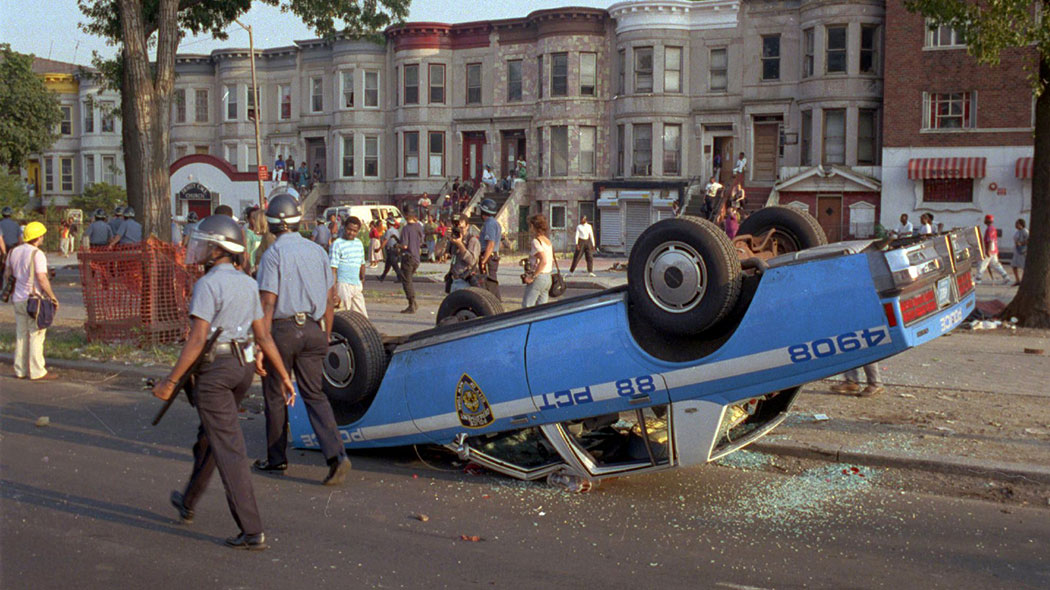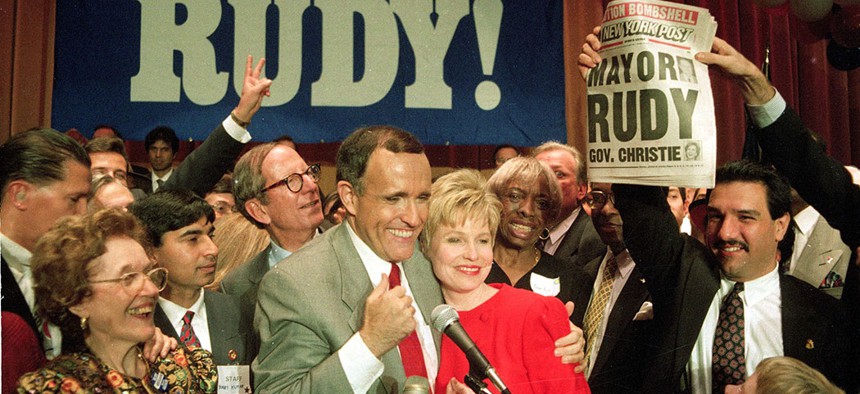Former New York City Mayor and President Donald Trump’s personal lawyer Rudolph Giuliani, who once held the honorary title of “America’s mayor,” has tarnished his legacy with his apparent orchestration of a plot to pressure Ukraine into digging up dirt on one of the president’s political opponents. To make matters worse for Giuliani, it was revealed last Thursday that two men associated with him and his Ukraine dealings were arrested and indicted on criminal charges for funneling foreign cash into U.S. elections.
Giuliani’s increasingly questionable behavior raises the question of how he rose to prominence by winning over New York City’s mostly Democratic electorate. After surveying news clips from the late 1980s and early 1990s, speaking with city historians and one of Giuliani’s strategists, it seems his mayoral win in 1993 it can be boiled down to five essential elements: faith lost in a seemingly ineffective mayor, a city desperate to curb crime, fraught race relations, the Crown Heights riots and a referendum to have Staten Island secede. It’s impossible to imagine Giuliani winning a citywide election today, but here’s how he did it.
Then-Manhattan Borough President David Dinkins won the 1989 mayoral race, beating Giuliani by just 2% – and in 1993 Giuliani won the mayoral election by a similarly thin margin. Polling numbers from the 1989 election show voters were largely unenthusiastic about both candidates. (Dinkins, who went on to become the city’s first black mayor, defeated three-term incumbent Mayor Ed Koch in the Democratic primary.)
Giuliani, who had risen to prominence as the U.S. attorney for the Southern District of New York in the 1980s, wasn’t a natural campaigner. He was known for being stiff, lacking warmth – something he made an apparent effort to overcome while campaigning in 1993 – and was considered by some to be a one-issue candidate focused on crime. “I voted for Dinkins in ‘89,” Fred Siegel, one of Giuliani’s strategists during the 1993 mayoral race, told City & State over the phone. “I reluctantly, at the last minute, ended up voting for Dinkins. I didn't think Koch deserved another term and I thought Rudy (Giuliani) was running for sheriff.”
Another impediment Giuliani faced was being a Republican in a city that overwhelmingly votes Democratic. This became somewhat less of a concern once Giuliani received an endorsement from the city’s Liberal Party when running for mayor in 1993, which gave Democrats a way to vote for him without pulling the lever for the GOP.
Dinkins had decades of political experience, although he had a reputation for being indecisive. Many thought Dinkins’ breaking the racial barrier at City Hall would have a unifying effect on the city.
In office, however, Dinkins developed a reputation for being disengaged and ineffectual. Some felt he showed favoritism toward the city’s black community during a racially charged boycott of Korean-American grocery stores in Flatbush, Brooklyn and when African-American and Caribbean-American rioters in Crown Heights, Brooklyn violently protested perceived governmental favoritism towards the area’s ultra-Orthodox Jewish population. Dinkins’ inaction gave the impression that he wasn’t up to the task of keeping the city under control. Even though it went down ever so slightly under Dinkins, Giuliani made crime a major focal point of his second mayoral campaign.
In 1990, New York City reported 2,605 homicides – a record high – the same year Dinkins took office. The city was frightened and looking for a reprieve. “There were more than 2,000 homicides a year in New York (in the 1990s) – they're under 300 now,” said Kenneth T. Jackson, a history professor at Columbia University. “It's a vast difference, though (crime) actually started to come down a little bit under Dinkins. The number of policemen in the city increased. Still, crime didn’t go down very much, just a little bit – the crime rate really went down under Giuliani.”
But it wasn’t just crime. There was a general sense of unrest – especially among Hispanic and white voters; a feeling that the city was uncontrollable and that the general quality of life in the city had declined. “People had simply written New York off,” Siegel said. “There was a sense that it was finished. It was the ungovernable city. And (Giuliani) didn't buy that. He had a sense of how it could be made governable again – and he achieved it, which is quite extraordinary.”
Giuliani had a successful and high-profile career as a federal prosecutor, where he took on organized crime, political corruption and malfeasance on Wall Street. His background in law gave many the impression that he was the right person to reform the wayward city. “I think Giuliani came across as a person who was a defender of law and order,” Jackson said. “In a way that he seems to have lost his bearing now, but that (law and order) was kind of his mantra. This person represented stability.”
Giuliani had numerous ideas and proposals to crack down on the city’s persistent crime, that most notably included the death penalty for convicted murderers (which is not within the mayor’s jurisdiction), ending parole for violent offenders (also not within the mayor’s jurisdiction), putting school safety in the hands of the NYPD, cracking down on drug dealers and their customers and ending aggressive panhandling, such as the notorious “squeegee men” who cleaned car windshields without permission and demanded payment for it. He also vowed to curtail funding for services that aided the homeless and limit stays at homeless shelters to 90 days. He convinced the city that he could actually implement a change in policing – which he did, for better and for worse.
The former prosecutor also had a friendly relationship with the city’s police force, as his involvement in a raucous, booze-driven 1992 police rally on the steps of City Hall demonstrated. The rally was organized in response to several issues that upset the NYPD, such as Dinkins’ refusal to approve the NYPD’s use of semiautomatic pistols, inviting the family of a man killed by the NYPD to Gracie Mansion and the consideration of a proposal to retool the force’s existing review board – which was one of Dinkins’ campaign promises. Giuliani was present during the rally leading drunken hoards of off-duty police officers in chants and criticizing Dinkins’ administration. “They (the off-duty officers) were giving Dinkins the finger right in front of City Hall.” said Jackson. “And Giuliani was their candidate. No question.”
The rally, led almost entirely by white officers, also signified the city’s palpable racial tensions during the time, between the city’s white and black communities. During the rally, officers’ used racial slurs to refer to Dinkins, chanted "the mayor's on crack.” Some held signs that referred to Dinkins as a “washroom attendant” and depicted him as a racist caricature with bulging lips and an afro. Giuliani’s participation in the rally also highlights what has become more apparent in recent years as his undeniable racial biases, but at the time it helped illuminate Dinkins’ inability to be the peacemaker his constituents hoped he would be – which benefited Giuliani, greatly.

In 1993, race was alluded to but not directly addressed until President Bill Clinton gave a speech at a fundraiser in support of Dinkins’ reelection in September. Clinton insinuated that voters had an aversion to voting for Dinkins because of his race, by saying that, "too many of us are still too unwilling to vote for people who are different than we are."
In October, Giuliani released an advertisement suggesting that Dinkins was using race to shame voters into voting for him. “The Dinkins campaign is trying to make this an election about race because they want to avoid the issue of competence," Herman Badillo, the Republican-Liberal New York City comptroller candidate at the time, said in Giuliani’s ad.
The Republican candidate didn’t just use his advertisement to accuse Dinkins’ of “playing the race card,” he also used it to take advantage of white voters’ racial anxieties about casting a vote for Dinkins. An unidentified white voter in Canarsie admitted that she wouldn’t vote for any black candidate at the time, and told The New York Times that black people "have proven themselves to be a hostile race."
Giuliani’s strategy worked, according to Jackson. “It seemed to many people that under Mayor Dinkins’ leadership, the racial divide in New York City was becoming larger,” Jackson said. “And Giuliani seemed to be the person who would put a lid on racial disagreement.”
Giuliani recognized that Dinkins had a majority of the city’s black vote in 1993 – though, many members of the black community were also left feeling disappointed by Dinkins’ leadership – so he put a lot of energy into trying to win over some of the city’s many other ethnic groups, such as the city’s Hispanic, Jewish and ethnic white communities such as Italian-Americans and Irish-Americans, for example by admonishing Dinkins for his ineffective leadership during the 1991 Crown Heights riots, which targeted Hasidic Jews.
Though the riots happened two years prior to the mayoral election year, Giuliani took advantage of the pain still felt within the neighborhood’s Hasidic community, making Dinkins faulty leadership during the riots one of the key focal points of his campaign. "I do not believe there would have been any confusion on the part of police in Crown Heights about when to make arrests,” Giuliani told a crowd of Jewish voters, in 1993. “I believe if I were mayor of New York City, they would have made arrests at the first moment that a rock was thrown through a store window, a car was burned or a person was beaten up because they were Jewish or for any other reason. "
Giuliani’s show of support the city’s the Jewish community most likely didn’t have a major effect on swaying the Jewish vote, it did help to sour Dinkins’ image and fostered the image of Dinkins being a weak leader, according to Daniel Soyer, a history professor at Fordham University, told City & State. A polling analysis from 1994 reveals that voters from all ethnic groups shifted slightly in Giuliani’s direction, in comparison to the numbers from 1989. But the voting remained heavily racially polarized in 1993: Giuliani got 77 percent of the white vote and Dinkins got 95 of the black vote, according to exit polls.
Other ethnic groups may have been on the fence about Giuliani, but a majority of the city’s white voters were more than enthusiastic about voting for the Republican candidate. Giuliani was very well received in predominantly white neighborhoods such as Bay Ridge, Brooklyn – and the whole of Staten Island.
In fact, Staten Island is believed to have helped push Giuliani over the finish line and clinch his mayoral victory, thanks to the borough’s high voter turnout tied to a referendum proposing Staten Island secede from the rest of the city. About 20,000 more Staten Island voters showed up to vote in 1993 than they did in 1989. “There was a substantial increase in turnout in Staten Island, which went heavily in Rudy's favor,” said Siegel.
Of course, Staten Island did not secede and has remained a part of the city, but what some would argue was the impetus for the secession movement – the city’s increasing non-white population – continued.
The city was considerably whiter back then. In 1990, 43.2% of the city’s population was white, in 2010 that number had dropped to 33.3%, according to U.S. Census Bureau data. If you were to rerun the 1993 race and had the same ethnic vote shares again in 2013, Giuliani would have lost the election. And if Giuliani attempted to run for mayor again today he most certainly wouldn’t have won – and that’s not even taking his recent cable news antics into consideration.


